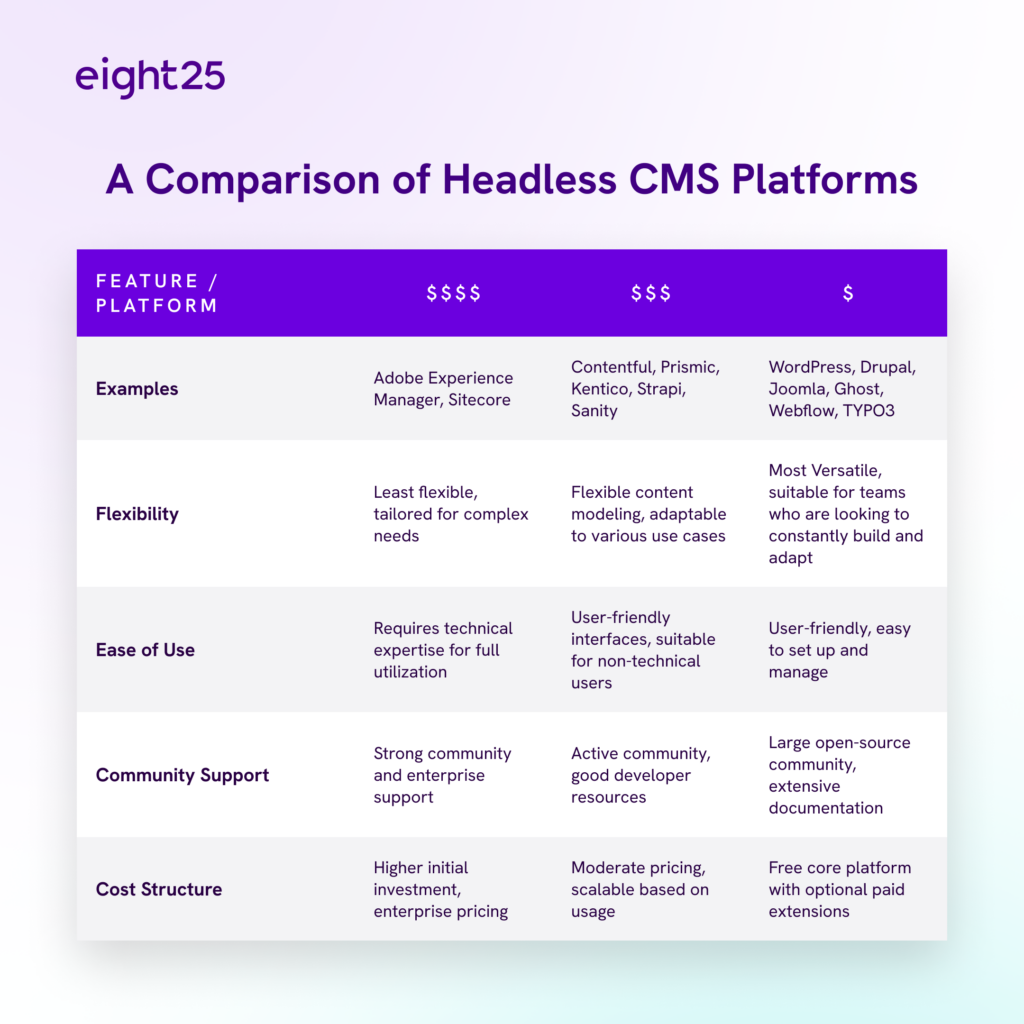Is a Headless CMS the Right Choice for Your Business? Here’s What to Consider

Should You Go Headless? Let’s break it down to three essential lenses: content distribution, scalability, and customization.
As digital experiences become more diverse, businesses are rethinking how they manage content. Gone are the days when publishing to a single website was enough.
Today, organizations are delivering content across mobile apps, smart devices, digital displays, and more—all while maintaining consistency and efficiency. This evolution has led many companies to consider moving to a headless CMS. But is it the right choice for your business?
In this article, we’ll help you decide by exploring three key areas:
- Content Distribution
- Scalability
- Customization
We’ll also provide a practical comparison of different CMS platforms based on flexibility, ease of use, community support, and cost.
What Is a Headless CMS?
Before we dive in, let’s define the term. A headless CMS is a content management system that separates the backend (where content is created and stored) from the frontend (where content is displayed to users). Instead of being tied to a specific website or presentation layer, the content is delivered via API to any platform—websites, mobile apps, smart TVs, voice assistants, and more.
This flexibility allows developers to use any technology stack they prefer on the frontend while maintaining a centralized content source on the backend.
1. Content Distribution: Do You Need Omnichannel Flexibility?
If your organization only needs to manage content for one website, a traditional CMS like WordPress or Drupal might be sufficient. But if you’re publishing content across multiple channels or planning to expand into mobile, IoT, or other digital platforms, a headless CMS offers significant advantages.
Key Questions to Ask:
- Do we need a centralized way to manage content for various channels?
- Are we delivering content across mobile apps, web platforms, digital signage, or even wearables?
If the answer is yes, then a headless CMS can help streamline your operations by allowing you to create content once and publish it everywhere. This not only reduces duplication of effort but also ensures a consistent brand voice across platforms.
A retail company may use a headless CMS to push product descriptions and marketing content to:
- Their eCommerce website
- A mobile shopping app
- In-store digital screens
- Email newsletters
- Voice-enabled shopping assistants
Rather than updating each channel individually, they can manage all content from one source and distribute it wherever needed.
2. For Occasional Updates or a CMS Tune-Up
Scalability is a top concern for growing businesses. As traffic increases, especially during promotions, product launches, or peak seasons, your content infrastructure must be able to keep up.
Traditional CMS platforms combine the backend and frontend into a single system, meaning any increase in frontend traffic also places a heavier load on the backend. This can lead to performance issues, slower page loads, and even site outages.
A headless CMS solves this by decoupling the frontend from the backend. Content is delivered via APIs, allowing the frontend to scale independently—often via edge delivery or CDN services.
Key Questions to Ask:
- Are we expecting significant growth in website or app traffic?
- Do we need the ability to scale our frontend and backend infrastructure separately?
If you anticipate high-traffic events or unpredictable spikes in usage, a headless CMS provides the flexibility and performance needed to deliver content reliably at scale.
3. Customization: Do You Need Complete Frontend Control?
Modern digital experiences often require more than just publishing text and images. From dynamic interfaces and interactive content to personalized user journeys, companies are building unique frontend experiences to stand out.
Traditional CMS platforms often limit frontend customization. You’re typically locked into pre-built templates, or you need to do considerable workarounds to implement modern JavaScript frameworks like React or Angular.
With a headless CMS, your development team can build entirely custom frontends using any tools they prefer. The CMS provides the content via API, and your frontend determines how that content is presented.
Key Questions to Ask:
- Are we planning to use modern front-end frameworks such as React, Angular, or Vue?
- Do we need highly customized digital experiences that go beyond templates?
If your website or app plays a critical role in your business—whether for eCommerce, lead generation, or customer engagement—having full control over the frontend can make a significant difference in performance, user experience, and long-term flexibility.
How Do Different CMS Options Compare?
Now that you’ve considered the strategic reasons to go headless, let’s look at how various CMS platforms stack up based on cost, flexibility, ease of use, and support.

Choosing the Right Tier:
- Enterprise solutions are best for large organizations with complex digital ecosystems and budget for dedicated IT teams.
- Mid-tier platforms strike a balance between flexibility and usability and are a good fit for growth-stage companies.
- Open-source platforms offer the most affordability and are perfect for small teams or businesses with in-house technical skills.
Is a Headless CMS Right for You?
Adopting a headless CMS is not just a technical upgrade—it’s a strategic move that reflects how you view content in your business. It’s ideal for organizations that:
- Publish content across multiple platforms
- Expect significant growth or traffic spikes
- Require high levels of frontend customization
However, it’s important to note that a headless CMS comes with its own challenges. It requires more development resources, clear content modeling, and investment in infrastructure. It’s not a plug-and-play solution for every business.
That said, for companies focused on long-term scalability, multi-platform delivery, and extreme flexibility, a headless CMS offers powerful advantages that can significantly improve both efficiency and user experience.
Before making the transition, evaluate your team’s capabilities, your current pain points, and your future goals. If content is at the core of your digital strategy, and you answered “yes” to any of the earlier questions, it may be time to explore a headless approach.
Need help choosing the right CMS tier or platform for your business? Let’s talk about aligning your tech stack with your growth goals.